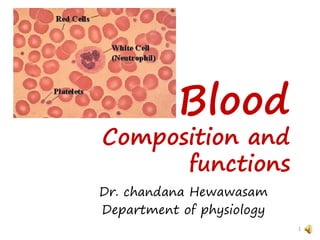
Blood .pdf
- 1. Blood Composition and functions 1 Dr. chandana Hewawasam Department of physiology
- 2. 2
- 3. Components of Blood • 8% of body weight • About 5.6 liters in volume • Whole Blood can be broken into 2 main components: – Plasma (55%) – Formed elements (45%). • Plasma itself consists primarily of: – Water (92%) – Plasma Proteins (7%) – Other solutes (1%). • The formed elements consist of: – Red blood cells (99.9%) – White blood cells (<0.1%) – Platelets (<0.1%) 3
- 4. Functions of Blood • Distribution 4 - oxygen - nutrients - metabolic waste - Hormones
- 5. • Regulation 5 -Regulate body temperature - Maintains normal pH - Maintains fluid volume
- 6. • Protection 6 - Clotting factors prevent blood loss - Blood borne immune elements prevent infection
- 7. • AGE • SEX • TEMPERATUR E • BODY WEIGHT • BODY SURFACE AREA • PREGNANCY • EXERCISE • POSTURE • HYPOXIA BLOOD VOLUME: PHYSIOLOGICAL VARIATIONS 7
- 8. Red Blood Cells Erythrocytes -erythros is Greek for red and cyte means cell. 8
- 9. 9
- 10. • Most abundant of the formed elements (99.9%). – In males, 1L of blood contains 5.4million RBCs. – In females, 4.8million RBCs. • Contain hemoglobin which binds and transports O2 and CO2. Its primary function is O2 transport. • The biconcave disk shape allows for more surface area, facilitating combination with oxygen • RBCs lack a nucleus and most organelles. • Life span- 120 days 10
- 11. Erythropoiesis = formation of erythrocytes • The body must produce about 2.5 million new RBCs every second • In adults, erythropoiesis occurs mainly in the marrow of the sternum, ribs, vertebral processes, and skull bones • Rate is regulated by oxygen level – Hypoxia (lower than normal oxygen levels) is detected by cells in the kidneys – Kidney cells release the hormone erythropoietin into the blood – Erythropoietin stimulates erythropoiesis by the bone marrow 11
- 12. Erythropoiesis begins these hemocytoblasts. In erythropoiesis, the hemocytoblast goes through a series of morphological changes - culminating in the formation of a Hb-filled and organelle-lacking erythrocyte. 12 hemopoetic stem cells (HSC) in bone marrows differentiate in to the hemocytoblasts.
- 13. Hematocrit (PCV) 45% Hematocrit : RBC volume = ~45% <1% Buffy Coat: WBC & Platelets 55% Plasma 13
- 14. • Red cell indicies 14 §MCV - Average red blood cell size Normal 80-95 fL < 80 – microcytes > 95 - macrocytes §MCH - Haemoglobin amount per red blood cell normal 27 - 32 picograms/cell §MCHC - The amount of hemoglobin relative to the size of the cell (hemoglobin concentration) per red blood cell Normal 32 - 36 grams/deciliter < 25 - hypochromic
- 15. ESR • ESR – Erythrocyte sedimentation rate - the rate of red blood cells sedimentation in column of blood within a period of one hour - a measure of acute phase response • Men under 50 years <15 mm/ 1sthr • Men over 50 years <20 mm/1sthr • Women under 50 years <20 mm/1sthr • Women over 50 years <30 mm/1sthr • For children : – Newborn- 0 to 2 mm/1sthr 15
- 16. Increased in:- infections (eg- Rheumatic fever, Infective endocarditis, osteomayelitis) inflammations some cancers(lymphoma, multiple myeloma) auto immune diseases (eg- SLE) anaemia Decreased in - polycythemia Leukemia congestive heart failure 16
- 17. • pic 17
- 18. White blood cells ( leucocytes) • have nuclei & do not contain hemoglobin • typical concentration is 4,000 - 11,000/L types of WBCs: -Granular white blood cells include: •neutrophils (50 - 70% of WBCs) •eosinophils (1 - 4%) •basophils (less than 1%) - Agranular white blood cells include: •lymphocytes (20 - 40%) •monocytes (2 - 8%) 18
- 19. 19 Neutrophils
- 20. • Raised in: – Bacterial infections – inflamation – Trauma – Surgery – Burns • Decreased in: – Viral infections – TB – Certain drugs, e.g. carbimazole, sulphonamides, methotrexate – Bone marrow failure 20
- 21. Eosinophils 21
- 22. Increased in- 22 Asthma Allergic conditions Parasitic infestations Skin diseases ,such as eczema,
- 23. Basophils 23
- 24. Monocytes 24
- 25. Monocytes • Raised in: – Acute and chronic infections (especially TB, brucellosis, protozoan disease) – Malignant disease (acute myeloid leukaemia and Hodgkin's disease) 25
- 26. Lymphocytes 26
- 27. • Circulating blood contains 2 main classes of lymphocytes • Lifespan of hrs to yrs. -T Lymphocytes(from thymus) Defend against foreign cells and tissues and coordinate the immune response. -B Lymphocytes(from bone marrow) Produce and distribute antibodies 27
- 28. All WBCs come from the same stem cell as the RBC - the hemocytoblast 28
- 29. Platelets (thrombocytes) • < 0.1% of formed elements of blood • Size – 2-4 m • Cytoplasm contains actin,myosin,glycogen,lysosomes • 2 types of granules: i .dense granules (non pr- ; ADP, seretonin) ii. granules (secrete pr- clotting factors & PDGF) • formed in the bone marrow from cells called megakaryocytes 29
- 31. Totipotent cells haemocytoblast Progenitor cells (proerythroblasts, mayeloblast,monoblast,lymphoblast, megakaryoblasts) RBC,WBC,PLATELETS 31
- 32. Plasma • Consist of two component • Water (with various diluted particles) • Plasma proteins(60-80 g/L) • Water Transports organic and inorganic molecules, formed elements and heat. • Plasma Proteins 32 -Albumins -Globulins -Fibrinogen -Regulatory pr-,other clotting factor
- 33. Abnormal Results of total plasma proteins: • Higher-than-normal levels may be due to: – Chronic inflammation or infection – Multiple myeloma • Lower-than-normal levels may be due to: – Liver disease – Malnutrition – Nephrotic syndrome 33
- 34. summary 34 •Functions of the blood •Factors that determine the total blood volume •Red blood cells -Structure -Functions -Red cell indicies •WBC -Structure -Functions •Platelets -Normal values -Functions •Plasma
- 35. 35